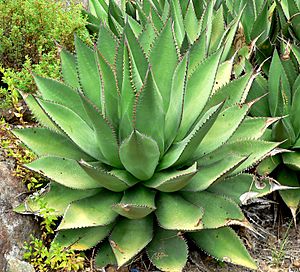Agave shawii facts for kids
Quick facts for kids Agave shawii |
|
|---|---|
 |
|
| Scientific classification | |
| Synonyms | |
|
Agave shawii, also called coastal agave or Shaw's agave, is a very rare and endangered plant. It is a type of Agave that grows naturally in southwestern California and Baja California in Mexico. This plant was named after Henry Shaw, who founded the Missouri Botanical Garden.
Contents
Where the Shaw's Agave Lives
This agave plant naturally grows in coastal areas along the Pacific Ocean. You can find it in northern Baja California in Mexico and in the very southwest part of San Diego County in California.
It is much more common in the wild in Baja California. In San Diego County, however, cities have grown so much that most of the plant's natural homes have been destroyed.
To help save the plant, Shaw's Agaves have been planted in places like the Torrey Pines State Natural Reserve and Cabrillo National Monument in San Diego. They have started to grow well there. There is also a large group of these agaves at the San Diego Botanic Garden in Encinitas, California, with almost 100 plants. The San Elijo Lagoon Nature Center in Encinitas also has Shaw's Agaves planted in its xeriscaping (gardens that use less water). You can also find some plants in the cactus garden at Friendship Park, which is on the border between San Diego and Tijuana.
What the Shaw's Agave Looks Like
Agave shawii is a plant that grows very slowly. It is a small to medium-sized agave. Its leaves are green and shaped like an egg (called ovate). They are usually 20–50 centimeters (about 8–20 inches) long and 8–20 centimeters (about 3–8 inches) wide. The edges of the leaves have different patterns of sharp teeth.
When the plant blooms, which happens at the end of its life, it grows a very tall flower stalk. This stalk can be 2–4 meters (about 6–13 feet) tall. It has 8–14 side branches, each with many yellowish or reddish flowers. Large purple leaves (called bracts) grow under these flower clusters.
The plant usually flowers from February to May. After it flowers, the main plant (called a rosette) dies. However, it can make new plants by sending out shoots from its base. Some groups of these plants grow as single plants, while others form large colonies of clones (exact copies).
Types of Shaw's Agave
There are a couple of different types of Agave shawii:
- Agave shawii var. shawii
- Agave shawii subsp. goldmaniana (Trel.) Gentry — This type is usually larger. It has longer leaves (40–70 cm or about 16–28 inches) that are shaped like a spear (called lanceolate). Its flower stalk can be 3–5 meters (about 10–16 feet) tall and has 18–25 flower clusters. This type is more common in the desert areas of the central peninsula.
Growing Shaw's Agave
Agave shawii is grown as an ornamental plant, which means people grow it because it looks nice. Special plant nurseries sell it. It is often used in cactus and succulent gardens and in drought-tolerant gardens, which need less water. It is also good for wildlife gardens.
This agave does not like cold weather. It can get damaged if the temperature drops to about -5°C (23°F) and gets badly hurt at -8°C (18°F). However, plants in pots have survived 18°F (about -8°C) without damage in some coastal areas. Covering plants with frost cloth can also help them survive very cold temperatures for many days.
These plants like sandy soil that drains water well. Their roots respond very quickly to rain. Dry plants have been seen to start growing new "feeder" roots within 3 hours after it rains.
Shaw's Agave can sometimes get tiny bugs called mealybugs. Growers should use treatments regularly to protect the plants. The plants look their best and have the brightest colors when they get full sun along the coast. If you are growing them further inland, they might do better with some shade from the hot afternoon sun.
This is a slow-growing plant. It can take 5 years for a young plant to grow large enough to fill a 2-gallon pot. Plants usually start to flower when they are about 30 years old. Before they die after flowering, they produce many new shoots. The best way to grow new plants from seeds is to plant them fresh, without needing any special treatment.
Images for kids
See also
 In Spanish: Agave shawii para niños
In Spanish: Agave shawii para niños














